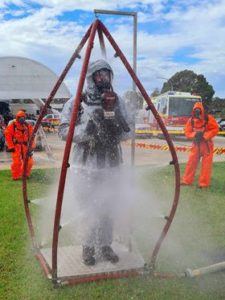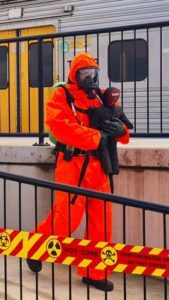In the world of emergency response, preparedness is paramount. It is crucial for firefighters and other first responders to receive comprehensive training to effectively handle various emergency scenarios.
Recently, firefighters at Fire and Rescue NSW in Australia took part in a simulated chemical suicide scenario located within a train carriage. The training scenario provided an opportunity for recruits to demonstrate their skills in rescuing casualties, conducting thorough train searches, rendering the spill safe, and decontaminating both the train and themselves.
We asked the team more about their training, and how using our manikins adds a new layer of realism to large-scale scenarios.
Setting the Stage: Simulating a Chemical Suicide on a Train

The train scenario is a simulated event designed to mimic the aftermath of a chemical suicide incident. Chemical suicide involves the deliberate release of toxic gases, often within a confined space, leading to high-risk situations. By staging this scenario on a train, recruits face the additional challenges of limited access points, confined spaces, and potential obstacles, thereby intensifying the training experience.
Rescuing Casualties and Conducting Train Searches
During the exercise, recruits were tasked with rescuing casualties and searching the train for an “all clear.” These objectives represented the first steps in securing the affected area. Rescuing casualties requires quick thinking, effective communication, and coordinated teamwork. To simulate a more realistic rescue scenario, F&R NSW included the use of our Adult and Child Duty training manikins, to represent the casualties.
Ruth Lee manikins are specifically designed for rescue training and can accurately simulate human body weight, size, and movement. Our manikins provide a lifelike representation of casualties, enabling recruits to practice their extraction techniques and assess the appropriate methods for safely removing individuals from hazardous environments, without the added risk to live volunteers or paid actors.
A systematic search of the train is essential to ensure no victims or hazards are overlooked. This comprehensive approach involves inspecting each compartment, evaluating potential hazards, and communicating findings to other team members. The use of manikins allows recruits to place simulated casualties in challenging situations, such as cramped spaces or areas with limited visibility, to replicate real-life scenarios accurately.
Rendering the Spill Safe and the Decontamination Process

Decontamination plays a pivotal role in ensuring the safety of both the train and the firefighters who operate in the “hot zone.” Recruits learned the proper use of personal protective equipment (PPE), decontamination procedures, and effective waste disposal methods. Ruth Lee manikins were also used during decontamination training to simulate individuals requiring thorough cleaning and removal of hazardous substances. The use of manikins allowed recruits to practice decontamination procedures while minimising the risk of exposure to harmful chemicals.
The Benefits of Using Training Manikins in Large-Scale Scenarios
In large-scale scenarios, such as the simulated chemical suicide on a train, the use of training manikins offers several significant benefits:
- Reduced Requirement for Live Volunteers or Paid Actors: Training manikins eliminate the need for live volunteers or paid actors, reducing logistical challenges and costs associated with organizing large-scale training exercises. This allows for more frequent and accessible training opportunities.
- Reduced Risk to Volunteers: Using manikins instead of live volunteers reduces the risk of injuries or accidents during training. Manikins are designed to withstand various rescue techniques and can be safely placed in challenging scenarios, such as confined spaces or hazardous environments.
- Realistic Training Scenarios: Ruth Lee training manikins offer a realistic simulated casualty, with accurate weight distribution, enabling recruits to practice lifelike rescue and decontamination techniques. The ability to simulate realistic scenarios enhances the training experience and prepares responders for real-life emergencies.
- Minimised Risk with Chemicals Involved: Chemical suicide scenarios involve hazardous substances that pose risks to human health. By using manikins, the exposure of live volunteers to potentially harmful chemicals is eliminated, ensuring their safety during training exercises.

We’re always glad to see our manikins being used in scenarios such as this by firefighters all around the world to enhance their training and provide realistic casualties to rescue, whilst reducing the risk to their colleagues or volunteers, ultimately helping to prepare responders for the complex challenges they may encounter in the field.
If you’re ready to introduce durable, realistically weighted manikins into your training scenarios please do not hesitate to get in touch – simply drop us an email or give us a call on 01490 413282
You can find out more about our training manikin range for Fire and Rescue here.
